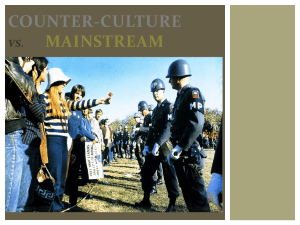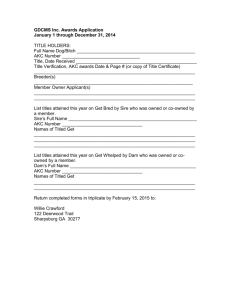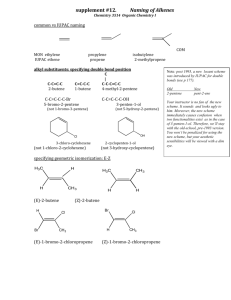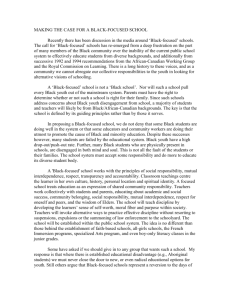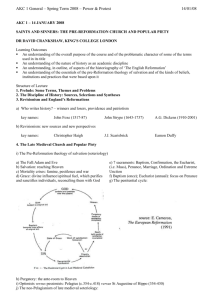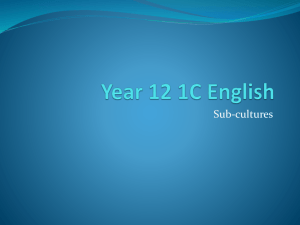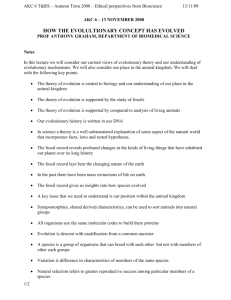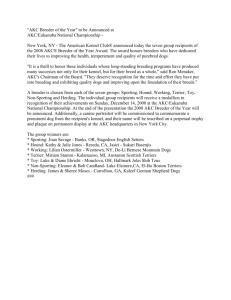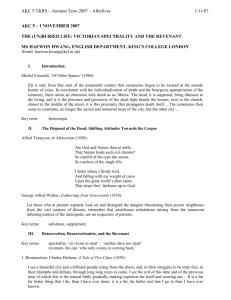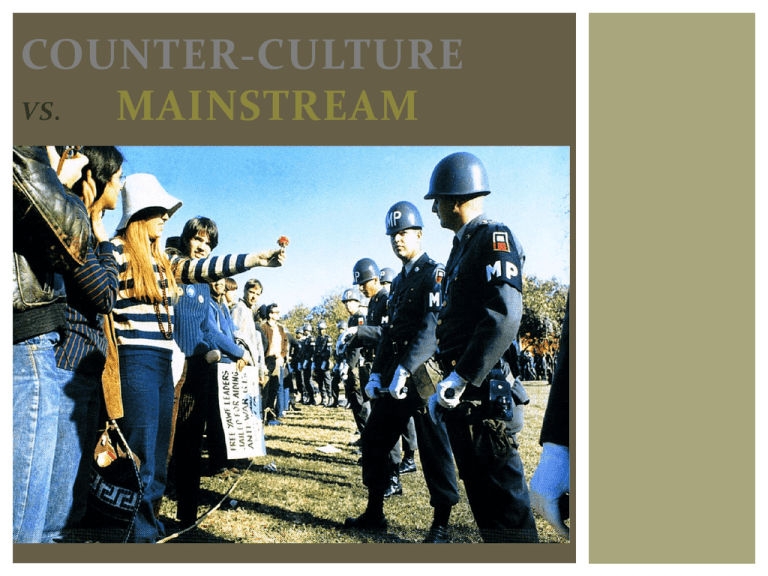
COUNTER-CULTURE
VS.
MAINSTREAM
MAINSTREAM CULTURE
The postwar era of 1945-1960 was a time of amazing econ
growth & prosperity for millions of Ams
These Ams- adult, mostly white, middle & upper class - were
the mainstream of the population
Survived Great Depression, fought WWII, & now expected lives of peace
They moved to suburbs, found good jobs, began families, assuming their
children would go to college and have even better lives than they did
4 concepts typified Mainstream America :
They were very patriotic (“America: Love it or leave it.”)
They believed in the institution of marriage (You fall in love, you get
married.)
They believed in the American Dream (Work hard and you can have a
good life)
They believed conformity kept society ordered (fashion, jobs, behavior,
etc)
THE COUNTERCULTURE
In the ’60s, group of mostly young, white Ams born just
after the war began challenging est’d mainstream values
Eventually known as the counter-culture, this
movement stressed pursuit of personal freedom &
alternative lifestyles, rebellion against conformity &
materialism.
Worked to stop racism, war, & poverty
6 ideas typified this movement
Communal living
Experimental Drug Use
Scandalous Fashions
Political Activism
New Music Styles
Sexual liberation/revolution
COMMUNAL LIVING
Many c-c youth moved to city centers like San
Fran’s Haight-Ashbury District & NYC’s East
Village, but another segment of the c-c left the city
altogether & set up communes in isolated places in
the mountains of CA or NM
They attempted to live their lives based on
cooperation & love, to live in harmony w/ nature ,
not conquer it
Despite moving to communes for equality and a
new lifestyle, many women still found themselves
in the same positions they had been in society
EXPERIMENTAL DRUG USE
For many c-c youth, drug use was an important part of
rebellion & personal freedom
While marijuana was most popular, the mind -altering
LSD (lysergic acid diethylamide) or “acid” was increasing in
use.
Harvard professor Timothy Leary urged people to “tune in, turn on, &
drop out”- a phrase that became a motto for c-c members to experiment
with drugs to achieve new “states of consciousness”
As drugs grew in popularity, newspapers & schools
pointed out the increasing numbers of youth dying
from drug overdoses
C-C members were quick to point out the mainstream
drug of choice: alcohol
SCANDALOUS FASHIONS
Calling themselves hippies (from the expression “hip”),
c-c youth dressed in outrageous clothing designed to
shock mainstream society
They wore:
Beads (both men & women)
Tie-dyed shirts (both men & women)
Men wore fringe jackets & army surplus
Women wore both mini-skirts & peasant skirts with
blouses designed to show midriffs (& they also went
braless)
Long hair was the norm for both men & women
POLITICAL ACTIVISM
For most of the mainstream, the c -c & the anti-war
movement were inseparably linked
By late ’60s, the TV was showing images of long -haired
protestors marching against the Vietnam War
Despite what most Americans thought, the antiwar
movement was not easily categorized
Some were confrontational- burning the flag, cursing &
goading police or Nat Guard troops
Others were interested in making a peace statement-
marching in silence, carrying peace signs, placing flowers
in the barrels of govt troops to prove their pacifism
These distinctions were lost on mainstream America
who saw them all as “filthy, long-haired, drugged-up, &
disloyal.”
NEW MUSIC STYLES
The folk, pop, & rock music of the 1960s also challenged
mainstream values.
Bob Dylan’s folk songs, like The Times They Are AChangin’, became c-c anthems, promoting social justice.
The Beatles sang about a “Revolution” inspiring youth to
change their world, while Joni Mitchell sang about
preserving nature in Big Yellow Taxi
By late 60s, psychedelic rock was in vogue w/groups like
Jefferson Airplane, Jimi Hendrix, & the Doors, Led
Zeppelin heavy guitar & explicit sex & drug references
In ’69, these elements all came together at a farm in NY at
the Woodstock festival. More than 500K people came
together to camp out, take drugs, engage in free love, &
listen to rock
SEXUAL REVOLUTION
The ’60s saw a revolution in the realm of human sexuality
and the c-c was largely responsible for it.
The c-c scoffed at their parents’ values & called them
sexually repressed.
They called for “free love” or casual sex .
Medical advances, like the birth control pill, made sexual
activity without fear of pregnancy easier.
Soon the country was seeing the effects of this “new
freedom”- women went braless, movies showed sex b/t
men and women, & songs made explicit references to sex
It should also be noted that the gay rights movement
began as a result of this new freedom
There was also an incredible rise in STDs & , despite
improved birth control, illegitimate children born

